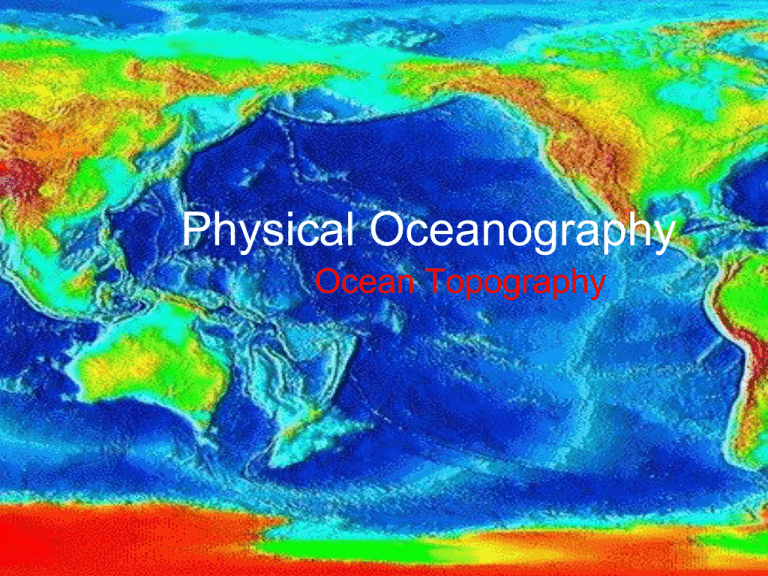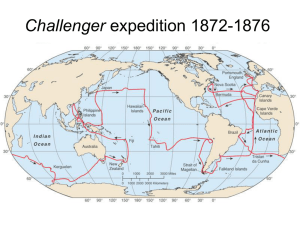Ocean Topogra..
advertisement

Physical Oceanography Ocean Topography What is topography? • The physical features of an area • The shapes, patterns and physical configuration of the surface of the ocean basins What do ocean basins look like? How do we know what it looks like? The ocean basin: Structures 1. Continental Margin: (near continent) Continental Shelf Continental Slope Continental Rise Submarine Canyons 2. Deep Ocean Basin: Abyssal Plains Oceanic ridges 3.a Trenches b Seamounts and Guyots c Atolls 1. Submerged, outer edge of the continents Two types: 1. Active Margin (Pacific) 2. Passive Margin (Atlantic) Continental Shelf: • Much more similar to the continent then the deep ocean. • They have hills, depressions, mineral and oil deposits. • In Atlantic Canada, the continental shelf hold the best fishing areas (Grand Banks and Scotia Shelf) Submarine Canyon: on the edge of the continental shelf • V-shaped indentations into the continental shelf, usually ending in a fan shaped wedge of sediments. How do submarine canyons form? • Thought to be turbidity currents and underwater landslides. (Turbidity currents are dense, sedimentladen currents which flow on a down slope when an unstable mass of sediment that has been rapidly deposited on the upper slope that fails, perhaps triggered by earthquakes). The Gully! • Submarine canyon off Nova Scotia • Marine protected area because of the rare corals found there • The natural gas pipeline goes right by it…problems? The Gully • "This species forms colonies up to two metres high and takes between 200 and 500 years to grow such a colony. They only grow 1.5 millimteres a year." L. Pertusa (Spider Hazards) Bubble Gum coral P. Arborea Largest reported from NS was 7m tall! 2.Deep Ocean Basin • Abyssal plains: From the Greek meaning “without bottom”. They are flat, cold, dark, featureless expanses of sediment-covered ocean floor. They are most common in the Atlantic • Ocean Ridges mountainous chains of actively spreading ocean floor. They can rise 2km from the ocean floor and sometimes form islands such as Iceland, the Azores and Easter island. Mid-Atlantic Ridge 3.Trenches! • deep gap in ocean floor, formed by movement of plates. • Example: Mariana Trench is 10,668 meters deep • They are among the most active areas on Earth. • They are the deepest areas of the Earth’s crust. • 90% of trenches are found around the Pacific rim. 4.Seamounts and Guyots Both are undersea volcanoes that originated at a hotspot or along a ridge Guyots once reached the surface of the ocean and have flat, eroded tops Seamounts never reached the surface, so they have pointy tops Example:Hawaii! 5. Atolls • A ring shaped island of coral reefs and coral debris. These often form over sinking inactive volcanoes. Where are atolls? • Most of the world's atolls are in the Pacific Ocean (with concentrations in the Caroline Islands, Marshall Islands, Coral Sea Islands, and the island groups of Kiribati and Tuvalu) and Indian Ocean • The Atlantic Ocean has no large groups of atolls other than eight atolls east of Nicaragua Read “Bubblegum corals from New Zealand seamounts and the deep sea” 1. Why are the called “bubblegum” coral? 2. What is the job of corals in an aquatic ecosystem? 3. What is unusual about the geographical patterns of these corals?





